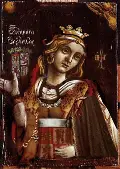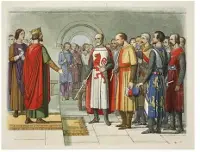King Edward I of England
Part 1: England Edward I was the tall, powerful, oldest son of England's King Henry III. He made a name for himself by carving out more territory for England at the expense of Scotland and Wales. A strong yet, at times, ruthless military commander and statesman, he was nevertheless a sound administrator and dedicated legal reformer. He had dreams of ruling all of Britain and very nearly succeeded. 
Born in 1239, Edward was named for his father's patron saint, Edward the Confessor, the Saxon monarch whose successionless death touched off a set of events that ended in the Norman Conquest. Young Edward did not have a strong constitution and barely survived a life-threatening illness in 1246. He went on to grow very tall (many sources say that he was 6-foot-2) and develop a fiery temperament and a ferocious temper. He had long arms and long legs and gained the nickname "Longshanks." 
When he was 15, Edward married Eleanor of Castile, a descendant of King Henry II and Eleanor of Aquitaine. The marriage, which took place on Nov. 1, 1254, was intended as merely a political alliance, but the couple fell deeply in love and had 16 children. Their first two sons, Henry and John, died very young; their third son, Alphonso, died at age 12. Their fourth son, also named Edward, survived into adulthood and became the heir to the throne. Edward's father, King Henry III, had engaged in a serious of military efforts to regain lands lost by his father, King John and had also sought to rule more absolutely, ignoring his advisors, and institute more repressive taxes, especially on the wealthy. 
By 1258, the barons had had enough and took Henry to task, reminding him that he needed their support in order to govern effectively. In one particularly memorable episode, a baron named Roger Bidog marched into Westminster in the middle of a conference that Henry was having with some advisors and delivered an ultimatum. Henry, fearing arrest and imprisonment, agreed to a restatement of Magna Carta, known as the Provisions of Oxford, which created a council of 15 nobles who would be his advisors. One of those nobles was his brother-in-law, Simon de Montfort, the Earl of Leicester. Simon's wife was Henry's sister, Eleanor. Henry tired of seeking his council's advice and dismissed them in 1261, reasserting personal rule. This was not a popular move with many people, especially his barons. By 1264, the barons had had enough and decided to revolt. The Second Barons War began. (The First Barons War was a struggle between nobles and King John, after John renounced Magna Carta.) By this time, Simon de Montfort had become disillusioned with Henry III. It was de Montfort who led an armed rebellion against the king. By this time, Edward was proving to be a solid soldier and an adept battle commander. The battle between royal and rebel forces took place at Gloucester. Edward was victorious. Robert de Ferrers, Earl of Derby, had sided with Montfort, and Edward did not forget this. A subsequent pitched battle resulted in Edward's taking Northampton from Montfort's son (also named Simon) and then ravaging lands owned by Derby. The two sides met in a fierce battle near the town of Lewes on May 14, 1264. The forces of Montfort were victorious, in part because Edward led a cavalry charge that took his men far away from the main battle, leaving his father's troops exposed. Montfort's forces closed in and seized the king, who surrendered. In the terms negotiated in the heated wake of the battle, Henry agreed that Edward would be a prisoner as well. The victorious barons forced Henry to relinquish much of his power; after this, Montfort took on all the trappings of a monarch for a time. 
Edward was under nominal house arrest for more than a year. He escaped on May 28, 1265, and set about reclaiming lands once ruled by his father. Edward proved more than equal to Montfort in terms of battlefield tactics and succeeded in separating the main rebel force from its main reinforcements, led by the younger Simon de Montfort. Thus it was that on August 4, 1265, the rebel forces were badly outnumbered at the Battle of Evesham. Edward's forces were victorious, and Montfort was killed. The younger Simon de Montfort fought on but didn't have the numbers and agreed to stop the fighting in March 1266. Edward succeeded in ending the rebellion through a combination of fighting and diplomacy. His father now safely re-enthroned, William turned his attention to another pursuit: the Crusades. He embarked on the Eighth Crusade in 1270, along with a cousin, Henry of Almain. Edward took his wife, Eleanor, with him. While they were in Sicily, descendants of Simon de Montfort killed Edward's cousin. Edward chose not to retaliate and continued on to the Holy Land. He arrived in Acre in May 1271. The Crusader forces took some Muslim possessions, but the two sides soon negotiated a truce that ended up lasting 10 years. Edward also took part in the Ninth Crusade. He survived an assassination attempt in June 1272, disarming a dagger-wielding attacker but not before enduring two wounds. The poison on the dagger caused Edward no amount of grief, but he survived. Edward was still in the Holy Land when his father died, in November 1272. He slowly made his way home and was crowned king. Next page > Scotland and Wales > Page 1 2 |
|
Social Studies for Kids
copyright 2002–2024
David White




